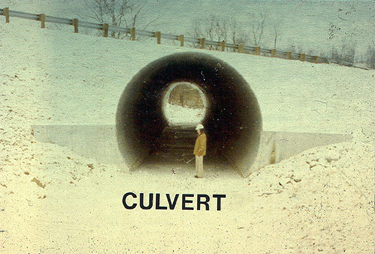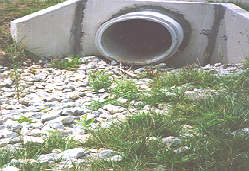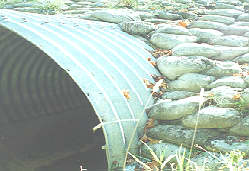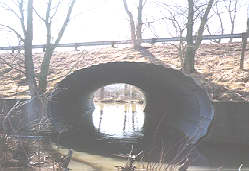
CULVERTS
The traditional definition of a culvert is a small structure that forms a hole through an embankment and has no superstructure, substructure or deck. This definition has become somewhat distorted in recent years with the introduction of the precast concrete rectangular box culverts (three- or four-sided), which can be installed with no fill on top of them. The traditional culvert was a simple round shape constructed of galvanized corrugated steel or of reinforced concrete.
CORRUGATED METAL GALVANIZED STEEL PLATE
In the mid 1960s, the corrugated metal pipe arch was introduced. This shape had a relatively flat bottom and a circular top with rather sharp radius corner plates. This shape was more efficient hydraulically especially during periods of low or moderate flow, because it allowed a greater flow of water with less disruption than a similar round shape. These culverts were constructed of multiple plates which had to bolted together in the field. One problem with this type of shape was the difficulty in compacting the backfill around it, especially around the sharp radius bottom corner plates. This shape also required that the bedding material be shaped to match the slight curvature of the bottom plates. This shaping was difficult to do and compacting around the corner plates took extra care, which many times was overlooked. Since corrugated metal structures are completely dependent on the quality and compaction of the backfill material around them to gain their strength, these types of structures often settled unevenly and/or developed cracks in the bottom corner plates. Galvanized corrugated steel structures were also prone to corrosion in the bottom plates. Since the steel plate thickness is relatively thin, it relies on the galvanizing to protect the steel. The galvanizing is also very thin and once it wears away from abrasion of sand and gravel in the streambed, the relatively thin steel corrodes through rather quickly. These types of structures are also prone to corrosion in the top plates caused by road salts migrating through the embankment, especially under the shoulder areas of the roadway. The plates are bolted together through the use of slightly oversized holes (to allow for fit-up), and leakage tends to come through these bolt holes. Not much can be done to correct some of these problems; however, if corrosion is starting to occur on the bottom plates, the deterioration can be slowed or stopped by placing a concrete bottom in the culvert. This will be discussed further in the future Repair section of this Manual.
FOUR-SIDED PRECAST CONCRETE BOX
The four-sided precast concrete box culvert was introduced in Ohio in the mid 1970s. Originally designed and built with 10' and 12' spans and various rises, these were cast in 6' to 8' segments, shipped to the job site and set in usually one day. The segments are joined together with a tongue-and-groove joint. The outside of the joints were waterproofed or in some cases the entire top and sides of the boxes were waterproofed. These box culverts have relatively thick walls (12") and are not dependent on the quality and compaction of the backfill for their strength; however, proper backfill techniques were necessary to eliminate settlement of the roadway on either side of the culvert. They are also designed to be installed with no cover, thus allowing for greater hydraulic efficiency than the corrugated metal structures. Four-sided box culverts are now available in spans up to 18'. These structures have been relatively maintenance free; however, joint leakage and lack of adequate concrete cover over the reinforcing steel has been a problem in some cases. Not much preventive maintenance can be accomplished on these structures other than making sure that they are kept cleaned out, and that the water is not restricted at the inlet. The inlet and outlet should also be checked for scour holes and dump rock added as necessary.
ALUMINUM BOX
The aluminum plate box culvert was introduced in Ohio in the mid 1980s. The structure consists of corrugated aluminum plates bolted together in the field. The shape consists of straight side plates (slightly tilted from vertical), bolted to relatively sharp radius top corner plates joined to flat top plates (see photo). The spans range from 10' to 18' with various rises available. Some designs consisted of a full invert (aluminum) flat bottom. These were placed on compacted granular bedding and backfilled. The advantage of this shape was that it could be completely constructed up on the roadway and lifted into the excavation in one piece. A few were built with the sides bolted to footer plates that were placed several inches below the streambed. Others were built with the sides bolted to an angle embedded in concrete strip footers cast in the streambed. These are probably more durable and not as prone to improper backfill than the others, but they also were more complicated and time consuming to construct because of the need to excavate, form and pour strip footers in the stream prior to installation. It was standard practice to construct aluminum box culverts using structural aluminum ribs bolted to the barrel, which adds stiffness. Not many problems have been reported with these structures to-date. The aluminum is probably more durable than corrugated steel for culverts because aluminum does not rely on a thin (galvanized) coating to protect the parent metal.
THREE-SIDED PRECAST CONCRETE BOX
The three-sided precast concrete culvert was introduced in Ohio in the mid 1980s a second generation to the four sided box culvert. By eliminating the bottom slab of the four-sided culvert, the span could be increased without a significant weight increase (for shipping purposes). There are two types of three-sided culverts: the flat top and the arched top (Conspan). The three-sided culverts must be placed on cast-in-place concrete footers. The flat top culvert is similar to the four-sided culvert in that it needs no fill and can be driven on, whereas the arch top culvert needs a minimum of 2' of fill. The arch top culvert is available in spans of 42' and does have some dependence on proper backfill for its stability; the flat top does not. Similar to the four-sided boxes, the three-sided culverts are precast in segments 4' to 6' wide and have butt joints instead of tongue-and-groove. The joints are waterproofed before backfilling and in some cases the entire top and sides are waterproofed. Again, these structures have been relatively maintenance free, with some joint leakage reported as well as some inadequate concrete cover over the reinforcing steel. These structures should be used in areas of limited fill over top because they cannot support large fills. At least one partial failure of an arched top has been reported due to too much fill and improper placement of reinforcing steel.
It is critical that the agency responsible for these types of culverts be on the lookout for evidence of erosion (scour) under the culvert or around the sides of the culvert. All should have properly designed and constructed headwalls and cutoff walls, especially at the inlets. It is also important that the inlet and interior be kept clear of debris and vegetation.
Preventive Maintenance Recommendations for Culverts:
- Pour concrete bottom in corrugated metal structures if corrosion of base metal has started.
- Keep interior of structure cleaned out.
- Remove vegetation and debris from inlet.


- Place dump rock/riprap along exposed footers, both sides of inlet, and at outfall.

- Remove saplings/trees growing in embankment above culvert.